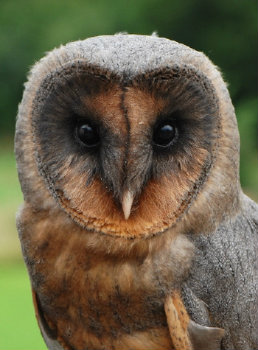Spirian Russet Owl
From Mizahar Lore
Bird
 | |
| Frequency | Medium |
|---|---|
| Threat level | Low, High when Provoked |
| Major features | Dark plumage with shocking red highlights in the tail, Shrill cries |
| Abilities | Capable of echolocation, able to use their cries to stun attackers, vicious when provoked |
| Most common in | The Spires, and Southern Taldera |
The Spirian Russet Owl is a fairly common sight in the night life of The Spires. Shocking reds are often considered a trait garnered from the red trunks of the forest. These birds are most welcome within the city and are very calm unless provoked.
Physical Characteristics
The Russet Owl is a large species of bird. They have six feet in wingspan and two and a half feet in their bodies. They are characterised by jet eyes and the red colourations in their feathers. The Russet Owl is native to Taldera and is a common sight during the night, where their shrill krii-krii cries resound across the forest as they hunt. During the day, it isn't hard to find one of their nests tucked into the trunk of a redwood. Generally the Russet Owl is a gentle bird, tame when in The Spires. Those outside of the city, are noticeably more aggressive. However, when one provokes the birds they flair their tail plumage and attack in a dazzling display of beauty and terror.
Newborns and juveniles are easily distinguished from the adults of the species by the chestnut tones in their faces and primaries. As they mature, the primary feathers become blood red while the face darkens to match the russet tone of their bodies.
Social Structure
Russet Owls live in mass colonies from birth until maturity, when they choose to make a nest elsewhere. The largest of these colonies is the one that resides in the Spires, while smaller ones dot the forest until they diminish entirely from northern Kalea and Sylira. The adults live alone until mating season, when they return to the colony they were born.
Russet Owl males compete for partners by incredible aerial acrobatics, flashing their red feathers in a display meant merely to impress the females. A successful male and his mate retreat into the nest the female hatched from originally. As many owls hatch in the same nest, owls that choose their mates slower are forced to build one, which is a time consuming process that may leave the male uninterested and in search of another mate.
Gestation for the pregnant females is a season long beginning in mid-Spring, with the laying of eggs in mid- to late Summer. The males leave the females to care for the young, returning to their lone nests, while within the nest, hungry juveniles may prey upon the newborn owls when hunting is scarce.
Mothers leave the young once they have fledged, which occurs sometime between late fall and early winter. Mature owls will leave the colonies with the mothers at this time, only to return in Spring, although copulation between recently fledged owls will be unsuccessful until the third year of maturity.
These birds may be able to live to fifteen years old in the wild, with every year increasing the depth of their feathers until they are nearly black by the time they pass.
Miscellaneous
Russet Owls are active hunters. Due to lacking the eyesight of their cousins, these owls have developed a way to utilize echolocation, and so can be detected by their shrill cries. Startling an owl will cause it to let out a high pitched shriek that leaves those in the vicinity dazed for a few moments, giving the owl time to escape. Due to the gentle nature of the Jamoura, it isn't uncommon for a Russet Owl to live extremely close to their dwellings, and as stated, the Spires is home to a large colony.